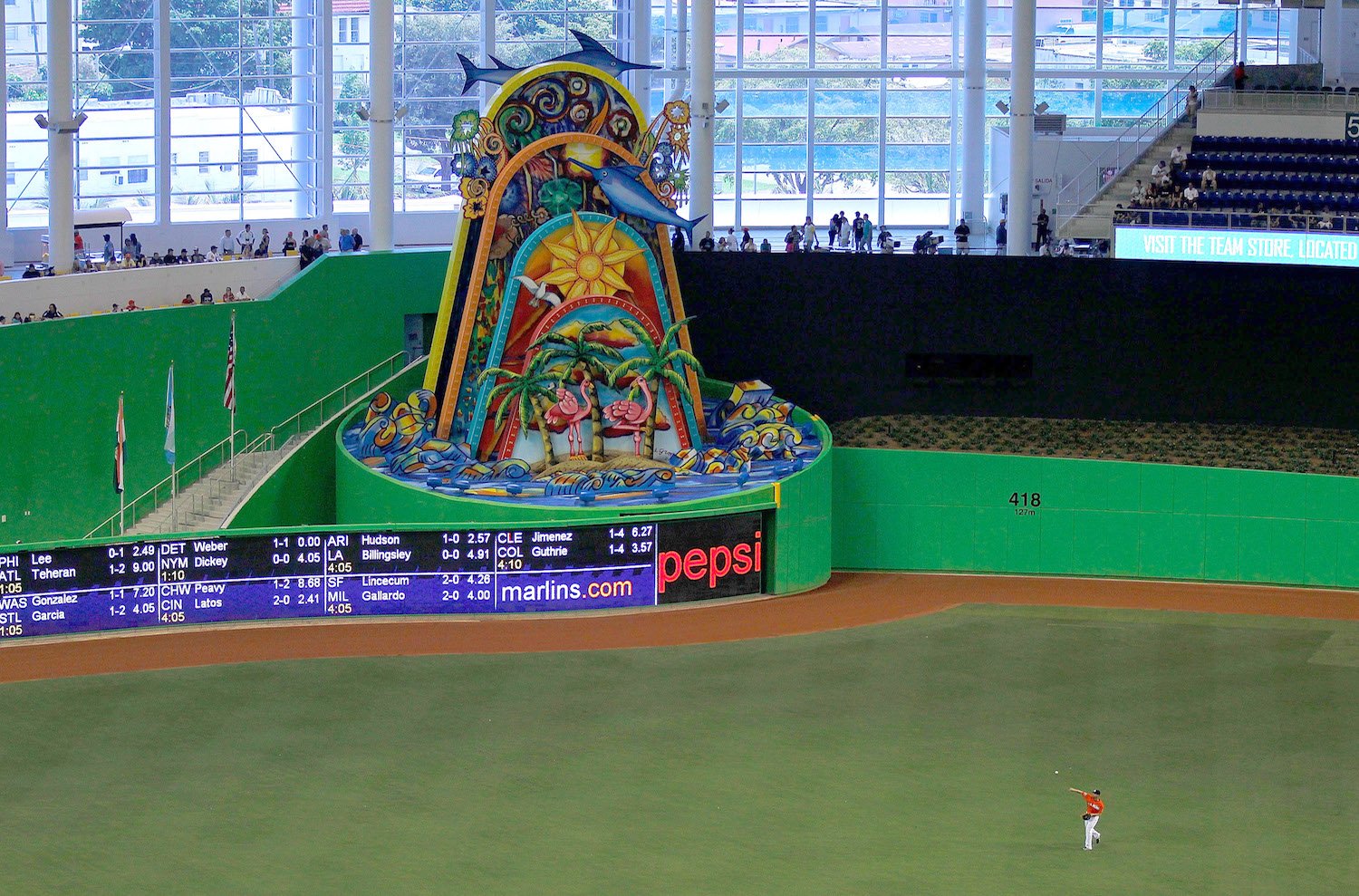
Derek Jeter may be a new owner of the Florida Marlins, but there’s one cut he won’t be able to make, apparently. The former Yankee captain wants to remove a $2.5 million home-run sculpture from his new team’s stadium. But the artwork’s owner is saying not so fast.
The 73-foot-tall artwork was created by artist Red Grooms and sits behind center field in Marlins Park. When a member of the Florida Marlins hits a home run, the work comes to life in a carnivalesque spectacle of flashing lights and bright colors. Mechanized marlins and flamingos whir, as 30 gallons of water shoot into the air.
The kitschy sculpture was originally commissioned by Miami-Dade County with public money, according to the Miami Herald. As a result, the county is technically the work’s owner—and it says the sculpture isn’t going anywhere.
“The county commissioned and purchased the Home Run Sculpture with the public art funds generated by the ballpark project,” Michael Spring, head of the county’s cultural affairs department, told the Herald. It “was designed specifically for this project and location and is permanently installed. It is not movable.”
Former New York Yankees captain Derek Jeter poses next to his number in Monument Park during the retirement ceremony of Jeter’s jersey #2 at Yankee Stadium. Courtesy of Elsa/Getty Images.
The work was installed as part of the city’s Art in Public Places program, which since 1973 has mandated that all new county buildings put 1.5 percent of their construction cost toward purchasing or commissioning artwork. (The stadium art collection also includes work by Joan Miró, Kenny Scharf, and Roy Lichtenstein, among others.)
Grooms told the Palm Beach Post that the movement of the piece is meant to suggest a roller coaster. He was inspired by the arches commonly seen in Miami’s colorful Art Deco-style architecture, and there’s no denying that it does have a certain quintessential South Florida flair.
Jeter is part of a group led by billionaire and Florida businessman Bruce Sherman that bought the team for $1.17 billion. The former Yankee shortstop chipped in $25 million, about two percent, and will be the team’s CEO. Since the deal was announced on August 11, the rumor mill has been abuzz with news that Jeter’s first plan of action was to get rid of the spectacle in center field—perhaps because it reminds him of the beloved Home Run Apple of the New York Mets, the Yankees’ crosstown rival?
If Jeter is truly angling for the artwork’s removal, he isn’t the only one. Local press, national sports publications, and fans have all roasted the sculpture since its installation in 2012.
“When activated, the monstrosity is as grotesque, obnoxious, and over the top as anyone possibly could have imagined,” wrote Yahoo Sports. “It’s like Lisa Frank designed a stage show for Liberace,” added a Reddit user. And in 2013, the Miami New Times stewed over the fact that the artwork’s cost was higher than the annual salaries of all but three players on the roster.
For his part, Grooms wasn’t too upset by public reaction to his work. “All those descriptions of gaudy, or extremely colorful, actually do apply to the majority of my work. So, as far as that’s concerned, it’s par for the course,” he told HuffPost, adding that he hoped the piece would eventually win the fans over.
He wasn’t wrong. SBNation’s Grant Brisbee initially hated the work, which he said looked as if “Carnival and Las Vegas had a baby.” By this year’s All-Star break, which saw Home Run Derby contestants essentially use the sculpture for target practice, he was singing a different tune: “This thing is incredible. It’s perfect.”
Despite the sculpture’s deep-seated unpopularity, many came to its defense upon learning of plans to remove it. “I’m telling you, the thing grows on you,” wrote Brisbee, noting that the artwork is one of the things that gives the Marlins character.
“Said sculpture is objectively a national treasure and should obviously be granted the legal protections that accompany landmark status,” insisted CBS Sports, while Sports Illustrated contributed this impassioned plea:
To get rid of the home run sculpture—or, as it’s informally known, the Miami Dinger Machine—would be heartless and cruel. Marlins Park is many things: a hideous ripoff of Miami-Dade taxpayers; a spaceship-looking piece of weirdness plopped into the middle of a residential area; and usually empty. But the stadium is also a brilliant distillation of all things Miami: It’s garish, overpriced, air conditioned to the point of becoming a meat freezer, and disdained by the locals. And the home run sculpture is a perfect symbol for that park, looking as it does like one of Lisa Frank’s more out-there nightmares.
“Look how fun it is!” added USA Today, posting a video of the work in action. “Baseball doesn’t like different. But it’s been five years. We’re all used to it now.”